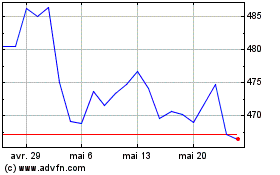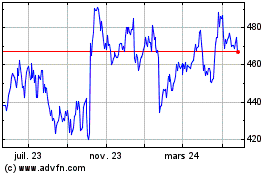Northrop Grumman Awarded $171 Million Contract to Begin Developing New Satellite Communications System for B-2 Bomber
11 Juin 2007 - 10:50PM
PR Newswire (US)
EHF Satcom system will speed delivery of battlefield information,
enable connection to Defense Department's global information
network PALMDALE, Calif., June 11 /PRNewswire-FirstCall/ --
Northrop Grumman Corporation (NYSE:NOC) has begun work on a
62-month, $171 million system development and demonstration (SDD)
contract for the first increment of a new extremely high frequency
(EHF) satellite communications system for the U.S. Air Force's B-2
stealth bomber. Under a planned three-increment upgrade program,
the new EHF system will eventually allow the B-2 to send and
receive battlefield information up to 100 times faster than its
current ultra-high frequency (UHF) satellite communications system.
Northrop Grumman is the Air Force's prime contractor for the B-2,
the flagship of the nation's arsenal of long-range strike aircraft.
"This SDD contract provides significant momentum for the work
Northrop Grumman and its subcontractors are doing to increase the
B-2's fighting effectiveness in the face of technological advances
by our enemies," said Dave Mazur, vice president of Long Range
Strike for Northrop Grumman's Integrated Systems sector. "It will
help ensure that the aircraft remains a well- integrated,
high-value node in the Air Force's long range strike structure."
The authority to proceed with the SDD phase follows the Air Force's
Milestone B decision in February authorizing Northrop Grumman to
proceed with this first increment of the EHF upgrade program, added
Mazur. During Increment I, the Northrop Grumman-led team will
replace the B-2's current flight management computers with a
single, integrated processing unit developed by Lockheed Martin
Systems Integration. The contract will also involve development of
the fiber optic network that will support high speed data transfers
to, from and within the aircraft; and delivery of a disk drive unit
from Honeywell Defense and Space that will facilitate future
transfer of EHF data onto and off of the B-2. Increment II of the
B-2 EHF program will give the aircraft the ability to send and
receive information at EHF frequencies, while Increment III will
fully integrate the new EHF communications capabilities into the
aircraft's controls and displays. According to Mark Rhoades,
Northrop Grumman's EHF Satcom program manager, the EHF Satcom
system will also allow the B-2 to connect easily to the U.S.
Department of Defense's Global Information Grid, a worldwide
network of information systems, processes and personnel involved in
collecting, storing, managing and disseminating information on
demand to warfighters, policy makers and military support
personnel. In particular, he notes, the EHF will make the B-2
compatible with both current and future secure military satellite
communications networks. "The B- 2 will help ensure continuity of
secure, worldwide military communications for allied commanders as
the current network of Milstar satellites transitions to the new
Advanced EHF satellite network," he said. The B-2's new EHF Satcom
system is the latest in a series of modernization programs that
Northrop Grumman and its subcontractors have undertaken with the
Air Force to ensure that the aircraft remains fully capable against
evolving threats. Other recent or current B-2 modernization
programs include: * A "smart" bomb rack assembly that allows the
aircraft to deliver 80 independently targeted, 500-lb. smart
weapons, five times more than previously; * Application of a
specially formulated surface coating that has significantly reduced
B-2 maintenance time and improved operational readiness; *
Installation of a line-of-sight tactical communications system that
improves B-2 pilots' ability to share critical targeting and threat
information and maintain real-time awareness of the battlespace;
and * Installation of an advanced electronically scanned array
antenna designed to enable more advanced imaging capabilities in
the future. The B-2 Spirit stealth bomber is one of the most
survivable aircraft in the world. It remains the only long-range,
large-payload aircraft that can penetrate deeply into protected
airspace. In concert with the Air Force's air superiority fleet,
which provides airspace control, and the Air Force's tanker fleet,
which enables global mobility, the B-2 helps ensure an effective
U.S. response to threats anywhere in the world. It can fly more
than 6,000 nautical miles unrefueled and more than 10,000 nautical
miles with just one aerial refueling, giving it the ability to
reach any point on the globe within hours. Northrop Grumman is a
$30 billion global defense and technology company whose 122,000
employees provide innovative systems, products, and solutions in
information and services, electronics, aerospace and shipbuilding
to government and commercial customers worldwide. DATASOURCE:
Northrop Grumman Corporation CONTACT: Brooks McKinney, APR of
Northrop Grumman Corporation, +1-310-331-6610, or cell,
+1-310-864-3785, Web site: http://www.northropgrumman.com/
Copyright
Northrop Grumman (NYSE:NOC)
Graphique Historique de l'Action
De Juin 2024 à Juil 2024

Northrop Grumman (NYSE:NOC)
Graphique Historique de l'Action
De Juil 2023 à Juil 2024
